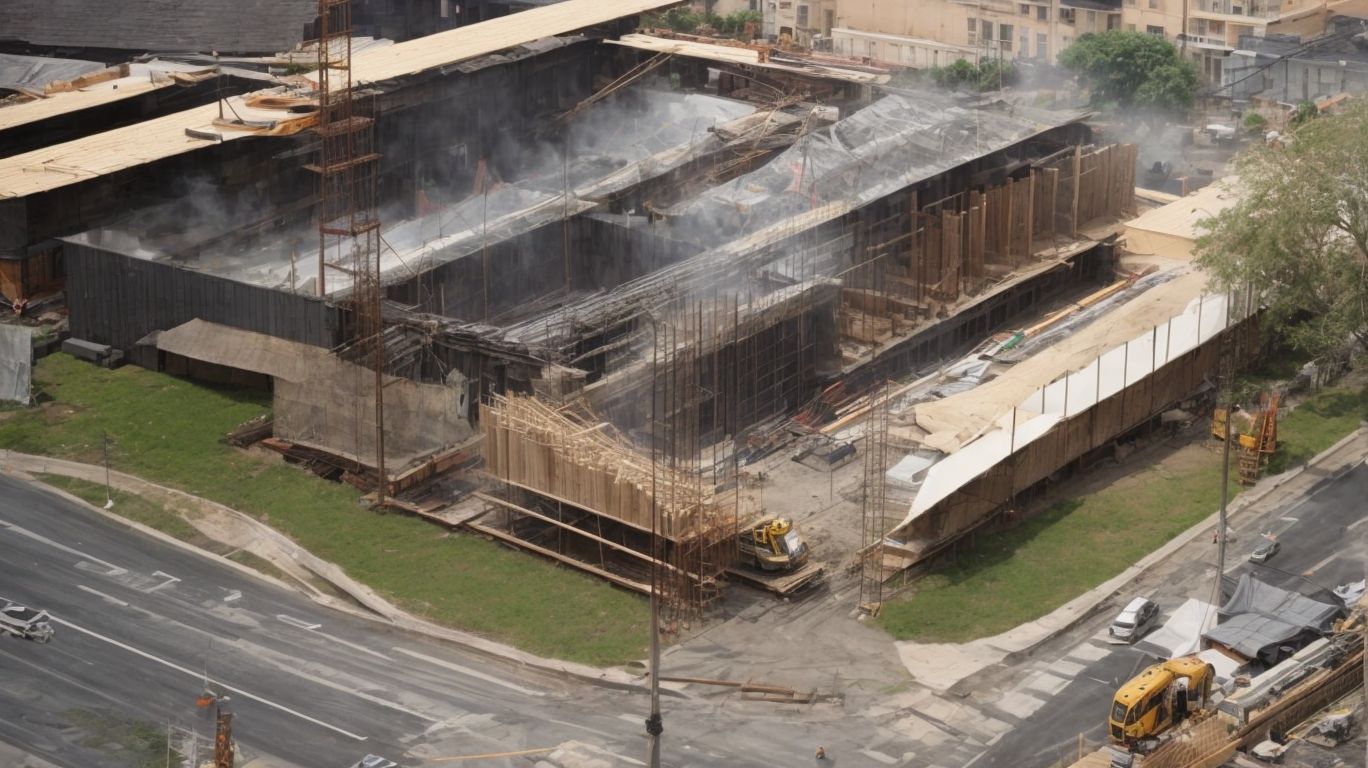
Financing Your Soft-Story Retrofit: Loans and Grants
If you’re a property owner considering a soft-story retrofit, you’re probably aware of the significant financial investment required for such a project.
In this article, we’ll explore the various financing options available to help you fund your retrofit, including loans, grants, and tax credits.
We’ll also discuss the eligibility criteria for obtaining a loan or grant, the types of loans available, and how tax credits can contribute to financing your soft-story retrofit.
So, let’s dive in and explore the financial avenues for your retrofit project.
What Is a Soft-Story Retrofit?
A soft-story retrofit refers to the structural modifications made to a building, particularly its lower stories, to enhance its earthquake resistance and overall structural stability. These retrofit measures are implemented to mitigate seismic hazards and improve the building’s safety and resilience against potential earthquakes.
Property owners are often encouraged to consider soft-story retrofits as a proactive approach to ensure the safety of their buildings and occupants. By strengthening the lower stories, the entire structure becomes more resistant to seismic forces, reducing the risk of collapse during an earthquake. This not only protects the investment in the property but also safeguards lives and minimizes the potential for extensive damage.
The significance of soft-story retrofits in enhancing earthquake safety cannot be overstated, as they contribute to the overall structural improvements and resilience of the built environment.
Why Is a Soft-Story Retrofit Necessary?
A soft-story retrofit is necessary to address the vulnerabilities of buildings with weak lower stories, making them susceptible to structural failure during seismic events. By implementing retrofit measures, property owners can significantly enhance the seismic resilience of their structures, reduce seismic risks, and make essential property improvements to ensure the safety of occupants and the building itself.
This proactive approach not only strengthens the structural integrity of the building but also helps in preserving investment value and preventing costly repairs in the aftermath of an earthquake.
It serves as a crucial strategy to protect lives, assets, and investments while contributing to a more resilient and secure community. Soft-story retrofits play a pivotal role in fortifying buildings, minimizing damage, and supporting overall disaster preparedness efforts. They are an integral part of creating a safer and more sustainable built environment in earthquake-prone regions.
What Are the Financing Options for a Soft-Story Retrofit?
Property owners seeking to undertake a soft-story retrofit have various financing options available, including loans, grants, and other funding sources, providing crucial financial assistance to support the retrofit endeavors.
These options encompass low-interest loans, grant programs, and diverse retrofit financing solutions tailored to meet the specific needs of building owners.
Property owners have various options to secure funding for their soft-story retrofit projects. These include obtaining low-interest loans from financial institutions, applying for grants through government programs, and exploring specialized retrofit financing options.
Financial support can come from local, state, or federal sources, each with its own eligibility criteria and application process. This allows building owners to find the right financial assistance program to suit their unique retrofit requirements.
Loans
Securing a loan for a soft-story retrofit involves navigating through various financing options, such as construction loans, with specific loan terms and conditions offered by different loan providers.
Property owners must carefully evaluate these loan offerings to determine the most suitable financing package for their retrofit projects. It is important to have a clear understanding of the various terms and conditions associated with loans, as they can greatly affect the cost and timeline of a retrofit project.
One type of loan, construction loans, are specifically designed for funding construction or renovation projects. These loans may have different interest rates, repayment periods, and eligibility requirements, all of which can impact the financial viability of a retrofit. As such, property owners should conduct thorough research and seek advice from reputable loan providers to find a financing option that fits their specific needs and budget.
Grants
Grants for soft-story retrofits play a pivotal role in providing financial support to building owners. There are diverse grant programs designed to enhance the eligibility and accessibility of grant funding.
Understanding the grant eligibility criteria and the availability of grant funding is crucial for property owners seeking retrofit assistance through grant initiatives. These grant programs are specifically structured to assist property owners in meeting the necessary criteria for eligibility, ensuring that the funding is allocated efficiently to address the retrofit needs.
By staying informed about the availability of grant funding, property owners can proactively pursue the necessary resources to make their buildings safer and more resilient. Through these grant programs, building owners can access financial assistance that significantly reduces the financial burden associated with retrofit projects, making it an invaluable resource for enhancing community safety and infrastructure resilience.
Tax Credits
Tax credits offer a valuable avenue for financing soft-story retrofits, with federal and state tax credit programs providing financial incentives and support to property owners undertaking seismic retrofit projects.
Understanding the nuances of these tax credit options is essential for maximizing the financial benefits of retrofit initiatives. Property owners can take advantage of tax credit programs to offset their retrofit expenses and improve the value and safety of their buildings.
For example, the federal tax credit for seismic retrofitting offers a significant rebate on qualified expenses. Additionally, state-specific programs may provide further financial relief.
Utilizing tax credits can also lead to long-term savings by reducing a property’s vulnerability to seismic damage, potentially lowering insurance premiums and maintenance costs over time.
What Are the Requirements for Obtaining a Loan for a Soft-Story Retrofit?
Obtaining a loan for a soft-story retrofit entails fulfilling specific requirements, including the submission of essential financial documents, proof of property ownership, and a comprehensive assessment of the retrofit costs.
Meeting these requirements is crucial for securing loan approval and initiating the retrofit process effectively.
One of the most critical aspects for loan approval in soft-story retrofitting is the thorough presentation of financial documentation. Lenders often require recent tax returns, income statements, and credit history to evaluate the borrower’s financial stability and capacity to repay the loan.
Providing clear proof of property ownership, such as title deeds and land surveys, is imperative to demonstrate the borrower’s legal ownership of the property in need of retrofitting. It is equally important to obtain accurate cost assessments for the retrofit, including structural engineering evaluations and construction estimates, to justify the loan amount requested. Fulfilling each of these prerequisites significantly increases the chances of obtaining the necessary funds for the retrofit project.
Good Credit Score
A good credit score is a fundamental requirement for loan applications related to soft-story retrofits, influencing the loan approval process and the associated repayment terms. Property owners must prioritize maintaining a strong credit profile to enhance their eligibility for favorable loan conditions and expedite the loan application process.
It is essential to understand that lenders extensively evaluate credit scores when determining the risk associated with extending a loan for soft-story retrofit projects. A higher credit score often translates to lower interest rates, reduced fees, and more flexible repayment terms.
Conversely, a lower credit score may lead to higher interest rates or even rejection of the loan application. Hence, property owners should proactively manage their credit profiles by making timely payments, reducing outstanding debt, and monitoring their credit reports for accuracy.
Proof of Property Ownership
Providing proof of property ownership is a critical requirement for securing loans for soft-story retrofits. This often involves submitting relevant documents, such as building permits and plans for property upgrades. Property owners must ensure that they fulfill these ownership criteria to facilitate the loan application process effectively.
This documentation not only serves as a validation of the property’s ownership but also showcases the property owner’s commitment to undertaking the necessary upgrades to enhance the building’s structural integrity.
Building permits play a crucial role in demonstrating compliance with local regulations and codes. This is essential for the approval of the retrofit loan. By adhering to these requirements, property owners can streamline the loan application process and expedite the approval of funds for much-needed soft-story retrofit projects.
Financial Documents
Submitting comprehensive financial documents is essential for securing loans for soft-story retrofits. These documents provide critical insights into the retrofit costs and determine the eligibility for financial aid and support.
Property owners must ensure the completeness and accuracy of these financial records for a successful loan application process. Financial documents are crucial in the loan approval process as they assist lenders in evaluating the property owner’s financial capability to undertake necessary retrofitting. They serve as evidence of projected costs, allowing financial institutions to assess the needed assistance.
Accurate and detailed financial records also demonstrate the property owner’s seriousness and commitment to the retrofit project, increasing the chances of receiving financial aid for structural upgrades.
What Are the Types of Loans Available for Soft-Story Retrofits?
Property owners exploring financing options for soft-story retrofits can consider various types of loans, including traditional bank loans, government-backed loans, and home equity loans, each tailored to address the specific requirements of seismic retrofit financing.
Understanding the characteristics of these loan types is pivotal in making informed financing decisions.
Traditional bank loans are a popular option due to their competitive interest rates and flexible repayment terms. On the other hand, government-backed loans, such as FHA loans, offer favorable terms for eligible property owners.
Home equity loans leverage the equity in the property to secure funds for retrofit projects. Each loan type has its implications for property owners, and carefully evaluating these options can lead to cost-effective and strategic financing decisions for soft-story retrofits.
Traditional Bank Loans
Traditional bank loans serve as a conventional financing option for soft-story retrofits, offering specific loan terms and conditions provided by various loan providers. Property owners must carefully review these terms and conditions to assess the viability of traditional bank loans for their retrofit endeavors.
Soft-story retrofit loans are available with fixed or variable interest rates and repayment periods of 5 to 30 years. Lenders may ask for a significant down payment and collateral, such as the retrofit property itself. Borrowers should be ready to provide detailed financial documents and undergo a thorough credit evaluation.
While traditional bank loans may offer lower interest rates and longer repayment periods, they come with strict qualification criteria and extensive paperwork. Despite this, they remain a popular option for soft-story retrofit financing.
Government-Backed Loans
Government-backed loans present a valuable financing avenue for soft-story retrofits, often accompanied by loan guarantee mechanisms and favorable terms provided by government entities.
Property owners can explore the benefits and conditions of government-backed loans to assess their suitability for retrofit financing.
These loans are backed by government entities, providing reassurance to lenders and lowering the risk for property owners seeking financing for retrofit projects.
Government-backed loans often offer competitive interest rates and longer repayment periods, making them a feasible option for property owners looking to undertake extensive soft-story retrofit projects.
The availability of these loans encourages property owners to prioritize retrofitting, contributing to overall community resilience and safer building structures.
Government-backed loans can significantly ease the financial burden of retrofit projects, ensuring that property owners can enhance the safety and structural integrity of their buildings effectively.
Home Equity Loans
Home equity loans offer property owners a financing avenue based on the assessed value of their property, providing diverse loan options tailored to the property’s value.
Understanding the implications of home equity loans and their relevance to property value is essential for making informed decisions regarding retrofit financing.
Property owners can access funds for vital home improvements, such as soft-story retrofits, by leveraging the equity built in their homes. The loan amount is determined based on the property’s value, making it a crucial factor in the process.
There are various loan options available, including home equity lines of credit (HELOCs) and fixed-rate home equity loans, providing flexibility in choosing the most suitable financing for the specific retrofit project.
By assessing their property’s value and exploring financing options, property owners can embark on necessary retrofit initiatives, ultimately enhancing the property’s resilience and value.
What Are the Eligibility Criteria for Grants for Soft-Story Retrofits?
Understanding the eligibility criteria for grants related to soft-story retrofits is crucial, with factors such as the location of the property, the age of the property, and the income level of the property owner serving as key determinants for grant eligibility.
Property owners must assess these criteria to gauge their suitability for grant assistance.
Property location plays a significant role in grant eligibility. Properties situated in high-risk seismic zones often receive priority.
The age of the property is a crucial consideration. Older structures are typically given preference due to their higher vulnerability to seismic events.
The income level of the property owner is an essential factor. Grants are often tailored to assist low to moderate-income households in undertaking necessary retrofit measures.
Location of Property
The location of the property holds significance in grant eligibility for soft-story retrofits. This is due to considerations such as building code compliance and the prevalence of seismic hazards shaping the grant assessment process.
Property owners must be aware of the impact of property location on grant criteria and assess its implications accordingly. They must understand the building compliance requirements in their area to be eligible for grants. Additionally, the property’s location can greatly impact the likelihood of seismic hazards, a key consideration for grant assessment.
It’s crucial for owners to grasp how these factors intersect when seeking grants for soft-story retrofits and ensuring the safety of their property.
Age of Property
The age of the property serves as a critical factor in grant eligibility for soft-story retrofits. There are specific retrofit requirements and considerations for ensuring the building’s structural stability. Understanding the implications of property age on retrofit requirements is essential for property owners seeking grant assistance.
When it comes to older properties, retrofit requirements usually involve addressing structural weaknesses. This can include things like weak or inadequate foundations, deteriorating support beams, and inadequate lateral bracing. These considerations are crucial for ensuring the safety and stability of a building during seismic events.
The age of a property is also important in the grant assessment process. This is because older structures are often more susceptible to damage in earthquakes, making them a higher priority for retrofit support.
Income Level of Property Owner
The income level of the property owner plays a pivotal role in grant eligibility for soft-story retrofits, impacting access to financial assistance programs and determining subsidy eligibility.
Property owners must assess their income level in relation to grant criteria to ascertain their qualification for grant support. This assessment is critical as it directly influences the grant assessment process. For property owners with lower income levels, various financial support and subsidy programs cater to their specific needs.
Understanding the relevance of these programs in the context of soft-story retrofits is essential for property owners seeking assistance. The alignment of income levels with grant requirements is fundamental in determining the extent of financial aid that may be available. As such, property owners should explore the different subsidy programs available to them and leverage them to maximize their eligibility for grants.
How Can Tax Credits Help Finance a Soft-Story Retrofit?
Tax credits offer a valuable avenue for financing soft-story retrofits, with both federal and state tax credit programs providing financial incentives and support to property owners undertaking seismic retrofit projects. Understanding the nuances of these tax credit options is essential for maximizing the financial benefits of retrofit initiatives.
These tax credit programs can significantly offset the costs associated with seismic retrofits, allowing property owners to make necessary structural enhancements while benefiting from attractive financial advantages.
Federal tax credit programs often offer substantial incentives, enabling property owners to recoup a portion of their retrofit expenses through tax credits. Similarly, state tax credit programs complement these federal offerings, enhancing the overall financial feasibility of soft-story retrofit projects.
By leveraging these tax credit incentives, property owners can not only improve the safety and resilience of their buildings but also realize substantial cost savings.
Federal Tax Credits
Federal tax credits provide valuable financial support for soft-story retrofits, often intersecting with grant application processes and enhancing building reinforcement initiatives.
Property owners must navigate through the specifics of federal tax credits to maximize their benefits for retrofit projects. These tax credits significantly impact grant applications by augmenting the financial resources available for retrofitting programs.
The alignment of federal tax credits with building reinforcement forms a crucial aspect of ensuring the structural resilience of existing properties. These credits play a vital role in promoting and incentivizing retrofit initiatives, thereby contributing to the overall safety and stability of vulnerable buildings.
State Tax Credits
State tax credits play a critical role in financing soft-story retrofits, often contributing to grant disbursement processes and incentivizing building code compliance.
Property owners must leverage their understanding of state tax credits to optimize their financial benefits and support for retrofit endeavors. Tax credits are a valuable incentive for property owners to invest in retrofit measures by offsetting a significant portion of the expenses. They also align with grant disbursement procedures, ensuring a seamless flow of financial support into retrofit projects. These credits play a crucial role in promoting building code compliance, enhancing the structural integrity and safety of vulnerable structures. Additionally, the availability of state tax credits supports the broader goal of promoting sustainable and resilient building practices through accessible financing options.




No Comments